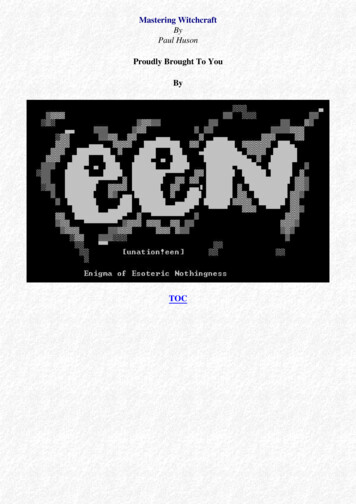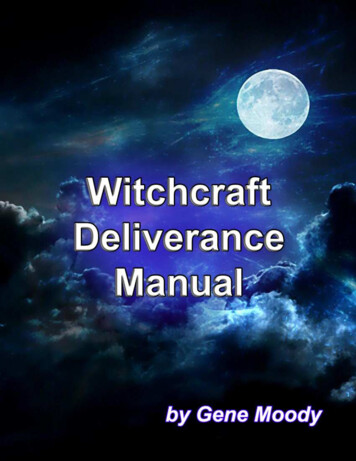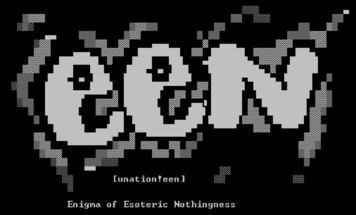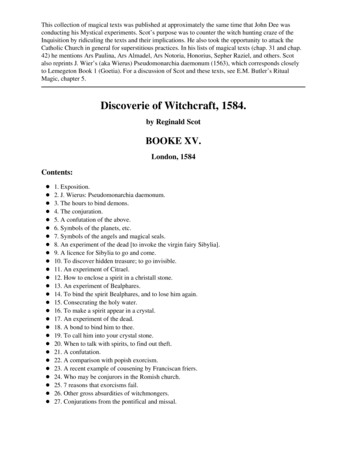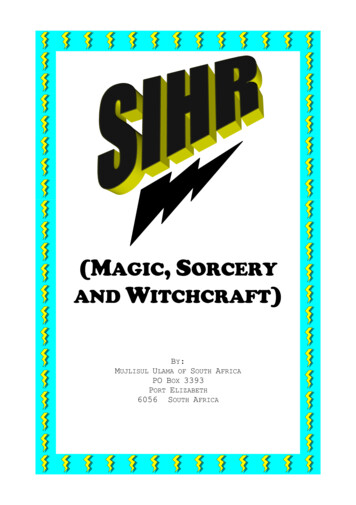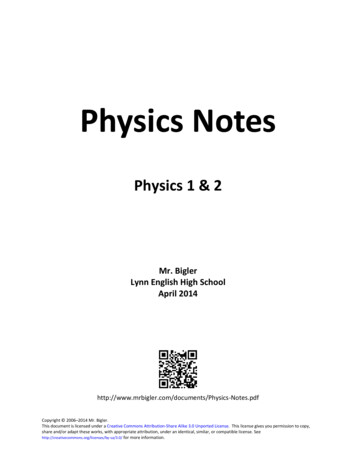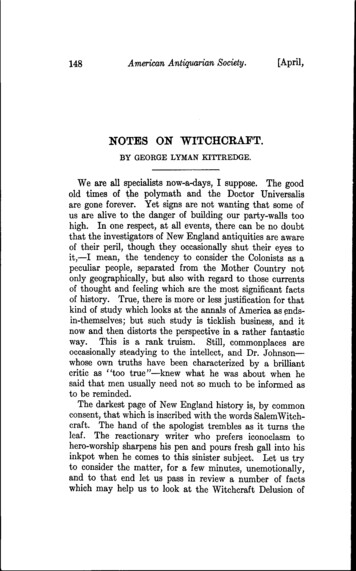
Transcription
148American Antiqmrian Society.[April,NOTES ON WITCHCRAFT.BY GEORGE LYMAN KITTREDGE.We are all specialists now-a-days, I suppose. The goodold times of the polymath and the Doctor Universalisare gone forever. Yet signs are not wanting that some ofus are alive to the danger of building our party-walls toohigh. In one respect, at all events, there can be no doubtthat the investigators of New England antiquities are awareof their peril, though they occasionally shut their eyes toit,—I mean, the tendency to consider the Colonists as apeculiar people, separated from the Mother Country notonly geographically, but also with regard to those currentsof thought and feeling which are the most significant factsof history. True, there is more or less justification for thatkind of study which looks at the annals of America as endsin-themselves; but such study is ticklish business, and itnow and then distorts the perspective in a rather fantasticway. This is a rank truism. Still, commonplaces areoccasionally steadying to the intellect, and Dr. Johnson—whose own truths have been characterized by a brilliantcritic as "too true"—knew what he was about when hesaid that men usually need not so much to be informed asto be reminded.The darkest page of New England history is, by commonconsent, that which is inscribed with the words SalemWitchcraft. The hand of the apologist trembles as it turns theleaf. The reactionary writer who prefers iconoclasm tohero-worship sharpens his pen and pours fresh gall into hisinkpot when he comes to this sinister subject. Let us tryto consider the matter, for a few minutes, imemotionally,and to that end let us pass in review a number of factswhich may help us to look at the Witchcraft Delusion of
1907.]Notes on Witchcraft.1491692 in its due proportions,—not as an abnormal outbreak*of fanaticism, not as an isolated tragedy, but as a mereincident, a brief and transitory episode in the biography ofa terrible, but perfectly natural, superstition.In the first place, we know that the New Englanders didnot invent the belief in witchcraft.-' It is a universallyhuman belief. No race or nation is exempt from it. Formerly, it was an article in the creed of everybody in theworld, and it is still held, in some form or other, and to agreater or less extent, by a large majority of mankind.** That the New Englanders brought their views on demonology and witchcraftwith them from the Mother Country is a self-evident proposition, but it may beworth while to refer to a striking instance of the kind. The Rev. John Higginson,writing from Salem to Increase Mather in 1683, sends him two eases for his Illustrious Providences,—both of which he "believes to be certain." The first is an accountof how a mysterious stranger, thought to be the devil, once lent a conjuring bookto "godly Mr. [Samuel] Sharp, who was Ruling Elder of the Church of Salem allmost30 years." The incident took place when Sharp was a young man in London. Thesecond narrative Mr. Higginson "heard at Gilford from a godly old man yet living.He came from Essex, and hath been in N. E. about 50 years. " It is a powerfullyinteresting legend of the Faust type, localized in Essex. In a postscript Mr. Higginson adds, " I had credible information of one in Leicestershire, in the time of theLong Parliament, that gave his soul to the Divel, upon condition to be a FamousPreacher, which he was for a time, «fee., but I am imperfect in the story." (MatherPapers, Mass. Hist. Soc. Collections, 4th Series, VIII, 285-287). See also the cases ofwitchcraft before 1692 collected in S. G. Drake's Annals of Witchcraft in New England. Dr. Poole is far nearer the truth in saying that "the New-England colonistshad no views concerning witchcraft and diabolical agency which they did not bringwith them from the Old World " (Witchcraft in Boston, in Winsor, Memorial History of Boston, II, 131) than President White is when he remarks that "the life ofthe early colonists in New England was such as to give rapid growth to the germs ofthe doctrine of possession brought from the mother country" (Warfare of Sciencewith Theology, II, 145).' A masterly short account of the various elements which made up the fully developed doctrine of witchcraft as it was held during the three centuries of especialprosecution (1400-1700), and of the sources from which these elements were derived,may be found in the first chapter of Joseph Hansen's Zauberwahn, Inquisition undHexenprozcss im Mittelalter (Munich and Leipzig, 1900). A learned and able essayby Professor George L. Burr, The Literature of Witchcraft, reprinted from thePapers of the American Historical Association, New York, 1890, should also beconsulted. Professor Burr emphasizes the sound and necessary distinction betweenwitchcraft and magic. But he seems to go too far in his insistence on this distinctionas vital in the history of witchcraft: "Magic itself is actual and universal. Butwitchcraft never was. It was but a shadow, a nightmare: the nightmare of areligion, the shadow of a dogma. Less than five centuries saw its birth, its vigor,its decay" (p. 238; p. 38 of reprint). This statement is true if by witchcraft is meant(and this is Professor Burr's sense) the fully developed and highly complicated systemset forth in the Malleus Maleficarum and in Del Rio's Disquisitiones Magicse.—whatHansen (p. 35) calls "der verhängnisvolle Sammelbegriff des Hexenwesens,"—which was not possible until scholasticism had schematized the diversified elementsof belief in magic and demonology and sorcery and devil-worship which Christiantheology and Christian superstition had derived from the most various sources—
150American Antiquarian Sodety.[April,Further, our own attitude of mind toward witchcraftis a very modem attitude indeed. To us, one who assertsthe existence, or even the possibility, of the crime of witchcraft staggers under a burden of proof which he cannotconceivably support. His thesis seems to us imreasonable,abnormal, monstrous; it can scarcely be stated in intelligiblefrom Judaism, classical antiquity, Neo-Platonism, and the thousand-and-one beliefsof pagan converts. But, important as this fully developed system was—and truethough it may be that without the schematizing influence of scholastio philosophythe witch-prosecution which was epidemic in Europe from 1400 to 1700 could hardlyhave taken place—we should never forget that the essential element in witchcraftis maleiidum,—the working of harm to the bodies and goods of one's fellow-menby means of evil spirits or of strange powers derived from intercourse with such spirits.This belief in maleficium was once universal; it was rooted and grounded in the mindsof the people before they became Christians; it is still the creed of most savages andof millions of Bo-oalled civilized men. Throughout the history of witchcraft (inwhatever sense we understand that word), it remained the ineradicable thing,—the solid foundation, unshakably established in popular belief, for whatever superstructure might be reared by the ingenuity of jurisconsults, philosophers, theologians,or inquisitors. Without this popular belief in malefidum, the initial suspicions andcomplaints which form the basis and starting-point of all prosecutions would havebeen impossible and inconceivable. With this popular belief, the rest waa easy.The error into which Professor Burr has fallen is due, no doubt, to his keeping hiseye too exclusively on the Continent, where the prosecutions were most extensive,where, in truth, the fully developed system was most prevalent, and where the inquisitorial methods of procedure give to the witch-trials a peculiar air of uniformity andtheological schematism. Thus he has been led, like many other historians, toover-emphasize the learned or literary side of the question. For us, however, as thedescendants of Englishmen and as students of the history of English colonies inAmerica, it is necessary to fix our attention primarily on the Mother Country. And,if we do this, we cannot fail to perceive that the obstinate belief of the common peoplein malefiáum— a belief which, it cannot be too often repeated, is not the work oftheologians but the universal and quasi-primitive creed of the human race—is theroot of the whole matter.(On savage witchcraft see the anthropologists passim.Good examples may be found in Karl von den Steinen, Unter den Naturvölkern Brasiliens, 1894, pp. 339 ff.)On maUfudum see especially Hansen, pp. 9 ff. Nothing could be truer than hiswords:—"Wie viel auch immer im Laufe der Zeit in den Begriff der Zauberei undHexerei hineingetragen worden ist, so ist doch sein Kern stet« das Maleficium geblieben.Aus dieser Vorstellung erwächst die angstvolle Furcht der Menschen und das Verlangennach gesetzlichem Schütze und blutig strenger Strafe; von ihr hat die strafrechtlicheBehandlung dieses Wahns ihren Ausgang genommen" (p. 9). "Daa Maleficium,mit Ausnahme des Wettermachens, ist ohne alle Unterbrechung von der kirchlichenund bis in das 17. Jahrhundert auch von der staatlichen Autorität als Realitätangenommen, seine Kraft ist nie ernstlich in Abrede gestellt worden; es bildet denroten Faden auch durch die Geschichte der strafrechtlichen Verfolgung" (p. 13).Everybody knows that the most convincing evidence of witchcraft—short ofconfession or of denunciation by a confederate—was held to be the damnumminatum and the malum secutum.The difference between England and the Continent in the development of thewitchcraft idea and in the history of prosecution is recognized by Hansen (p. 34,note 1). President White, like Professor Burr, has his eye primarily on the Continent (Warfare of Science with Theology, 1896, I, 350 ff.). Bis treatment of demoniacal possession, however, is much to our purpose (II, 97 ff., 135 ff.).
1907.]Notes on Witchcraft.151terms; it savors of madness. Now, before we can do anykind of justice to oiir forefathers,—a matter, be it remembered, of no moment to them, for they have gone to theirreward, but, I take it, of considerable importance to us,—we must empty our heads of all such rationalistic ideas.To the contemporaries of William Stoughton and SamuelSewall the existence of this crime was not merely an historicalphenomenon, it waff a fact of contemporary experience.Whoever denied the occurrence of witchcraft in the past,was an atheist; whoever refused to admit its actual possibility in the present, was either stubbornly incredulous,or destitute of the ability to draw an inference. Throughoutthe seventeenth century, very few persons could be found—not merely in New England, but in the whole world—whowould have ventured to take so radical a position. Thatthere had been witches and sorcerers in antiquity wasbeyond cavil. That there were, or might be, witches andsorcerers in the present was almost equally certain. Thecrime was recognized by the Bible, by all branches of theChurch, by philosophy, by natural science, by the medicalfaculty, by the law of England. I do not offer these postulatesas novelties. They are commonplaces. They will not be attacked by anybody who has even a slight acquaintance withthe mass of testimony that might be adduced to establish them.It is a common practice to ascribe the tenets of the NewEnglanders in the matter of witchcraft to something peculiarabout their religious opinions,— to what is loosely calledtheir Puritan theology. This is a very serious error. Thedoctrines of ovir forefathers differed, in this regard, fromthe doctrines of the Roman and the Anglican Church in noessential,—one may safely add, in no particular. LordBacon was not a Puritan,—yet he has left his belief in sorceryrecorded in a dozen places. James I. was not a Puritan, butKing James's connection with the history of witchcraft alnaost deserves a monograph, for it has never been adequately discussed, and various misconceptions onthe subject are afloat. Thus Mr. H. M. Doughty, in an interesting but one-sidedessay on Witchcraft and Christianity (Blackwood's Magazine, March, 1898, CLXIII,388), remarks that "the new King James had long lived in abject fear of witches"—an assertion that he would find it impossible to prove, even if it were true, as itseems not to be.
152American Ardiquarian Sodety.[April,his Dsemonologie (1597) is a classic treatise, his zeal inprosecuting sorcerers is notorious, and his statute of 1603*was the act under which Matthew Hopkins, in the time ofthe Commonwealth, sent two hundred witches to the gallowsin two years,—nearly ten times as many as perished inMassachusetts from the first settlement to the beginningof the eighteenth century.Matthew Hopkins, the Witch-Finder General, apparentlywas a Puritan. Indeed, it is his career, more than anythingthat ever happened in New England, which has led tothe reiterated statement that Puritanism was especiallyfavorable, by its temper and its tenets, to prosecution forwitchcraft. For his activity falls in the time of the Commonwealth, and the Parliament granted a Special Commission ofOyer and Terminer, in 1645, to try some of the witchesthat he had detected, and Edmund Calamy was associatedwith the Commission. But, on the other hand, it must benoted that John Gaule, who opposed Hopkins and is usuallycredited with most influence in putting an end to his performances, was also a Puritan,—and a minister likewise, and abeliever in witches as well. The Hopkins outbreak, as weshall see, must be laid to the disturbed condition of thecountry rather than to the prevalence of any particularsystem of theology. Under Cromwell's government, witchtrials languished, not because the belief in witchcraft changed,but because there was order once more. So in Scotland,* The act oí 5 Eliz. o. 16 (after reciting that 33 Henr. VIII. c. 8 had been repealedby 1 Edw. VI. o. 12) prescribes the penalty of death for witchcraft which destroyslife, imprisonment for that which causea bodily injury (death for the second offence);in certain harmless kinds of sorcery (such as accompanied the search for treasureor stoien goods) the second offence is punished by imprisonment for life. 1 Jac.I. c. 12 follows 5 Eliz. c. 16 in the main. Its chief differences are,—greater detailin defining witchcraft; the insertion of a passage about digging up dead bodies forpurposes of sorcery; death for the first offence in cases of witchcraft which causesbodily injury; death for the second offence in treasure-seeking sorcery and the like.Before one pronounces the new statute much severer than the old, it would be wellto examine the practical operation of the two. In particular, one ought to determine how many witches were executed under the law of James I. who would nothave been subject to the death penalty under the law of Elizabeth. This is not theplace for such an examination. On treasure-seeking sorcery see the iearifed andentertaining essay of Dr. Augustus Jessopp, Hill-Digging and Magic (in his RandomKoaming and Other Papers, 1893)." See p. 209 below. Strictly speaking, the Commonwealth did not begin until1649, but this point need not be pressed.
1907.]Notes on Witchcraft.153the conquest by Cromwell checked one of the fiercest prosecutions ever known. The Restoration was followed, bothin England and in Scotland, by a marked recrudescence ofprosecution.'But we must return to Matthew Hopkins. Let us seehow his discoveries affected James Howell. In 1647 Howellwrites to Endymion Porter: "We have likewise multitudesof Witches among us, for in Essex and Suffolk there wereabove two himdred indicted within these two years, andabove the one half of them executed : More, I may well say,than ever this Island bred since the Creation, I speak itwith horror. God guard us from the Devil, for I think hewas never so busy upon any part of the Earth that was enlightned with the beams of Christianity; nor do I wonder at it,for there's never a Cross left to fright him away." In thefollowing year, Howell writes to Sir Edward Spencer anelaborate defence of the current tenets in witchcraft anddemonology.* One striking passage demands quotation:—"Since the beginning of these unnatural Wars, there maybe a cloud of Witnesses produc'd for the proof of this blackTenet : For within the compass of two years, near upon threehundred Witches were arraign'd, and the major part executedin Essex and Suffolk only. Scotland swarms with them nowmore than ever and Persons of good Quality executed daily."It is confidently submitted that nobody will accuse Howellof Puritanism. The letters from which our extracts aretaken were written while he was a prisoner in the Fleet See F. Legge, Witchcraft in Scotland (Scottish Review, XVII1,''267); ThomasWright, Narratives of Sorcery and Witchcraft, Chap. xxv. Whitelocke, under dateof Oct. 4,1652, notes "Letters that sixty Persons Men and Women were accused beforethe Commissioners for Administration of Justice in Scotland at the last Circuit forWitches; but they found so much Malice and so little Proof against them that nonewere condemned" (Memorials, 1732, p. 645). Cf. also hia very important entry onthe same subject under Oct. 29, 1652 (pp. 547-548).' Epistolœ Ho.E!ianœ, Familiar Letters, edited by Joseph Jacobs, 1890, book ii,letter 76, p. 506: "To my Honourable Friend, Mr. E. P., at Paris" (cf. Jacohs'snotes pp. 783-784). The letter is dated "Fleet, 3 Feb. 1646." This is certainlyOld Style. Howell is a queer dater, but a reference in this letter to the departureof the Scottish army (p. 505) proves that the letter was written after Deo. 21, 1646.There is a similar passage about witches in book iii, letter 2, p. 515 (also to Porter),dated "Fleet, 20 Feb. 1646."' Letters, as above, book iii, no. 23, pp. 547 Cf., dated "Fleet, 20 Feb. 1647," i. e.doubtless 1648.
154American Antiquarian Society.[April,under suspicion of being a Royalist spy. His mention ofthe disappearance of crosses throughout England will notbe overlooked by the discriminating reader. It will be notedalso that he seems to have perceived a connection—a realone, as we shall see later— " between the increase in witchcraft and the turmoil of the Civil War.Jeremy Taylor was surely no Puritan; but he believedin witchcraft. It is a sin, he tells us, that is "infalliblydesperate,"" and in his Holy Living (1650) he has evengiven the weight of his authority to the reality of sexualrelations between witches and the devil.- It was not in Puritan times, but in 1664, four years afterthe Restoration, that Sir Matthew Hale, then Chief Baronof the Exchequer, pronounced from the bench the followingopinion in the Bury St. Edmunds case:—"That there weresuch Creatures as Witches he made no doubt at all; For First,the Scriptures had affirmed so much. Secondly, The wisdomof all Nations had provided Laws against such Persons,which is an Argument of their confidence of such a crime.And such hath been the judgment of this Kingdom, asappears by that Act of Parliaments which hath providedPunishments proportionable to the quality of the Offence.And desired them [the jury], strictly to observe theirEvidence; and desired the great God of Heaven to directtheir Hearts in this weighty thing they had in hand: Forto Condemn the Innocent, and to let the Guilty go free, wereboth an Abomination to the Lard." * Hale's words were' See Jacobs's Introduction, pp. xlii-xliii.The question whether Howell's letterswere actually sent to the persons to whom they are addressed or whether they areto be regarded merely as literary exercises composed during his imprisonment (seeJacobs, pp. lxxi f.) does not affect, for our purposes, the value of the quotationshere made, since the letters to which we now refer actually purport to have beenwritten in the Fleet, and since they were first published in the second edition (1650)in the additional third volume and from the nature of things could not have appearedin the first edition (1645). They must, at all events, have been composed before1650, and are doubtless dated correctly enough." See p. 209, below." tjermon xvii (Whole Works, ed. Heber and Eden, 1861, IV, 546)."Whole Works, III, 57; cf. Sermon vii (Works, IV, 412)." See p. 152, above, note 4."A Tryal of Witches, at the Assizes held at Bury St. Edmonds . . 1664 (London,1682), pp. 55-56. This report is reprinted in Howell's State Trials, VI, 647 if., and(in part) in H. L. Stephen's State Trials Political and Social (1899), I, 209 f. See
1907.]Notes on Witchcraft.155fraught with momentous consequences, for he was ' 'allowedon all hands to be the most profoimd lawyer of his time, " and the Bury case became a precedent of great weight. ' 'Itwas," writes Cotton Mather, "a Tryal much considered bythe Judges of New England." *Hale's conduct on this occasion has of course subjectedhim to severe criticism. Lord Campbell, for example,goes so far as to declare that he "murdered" the oldwomen,—a dictum which shows but slight comprehension of the temper of the seventeenth century. Morecreditable to Campbell's historical sense is the following passage:—"Although, at the present day, weregard this trial as a most lamentable exhibition ofcredulity and inhumanity, I do not know that it atall lowered Hale in public estimation in his own life.""Bishop Bumet, as is well-known, makes no mentionalso Hutchtnson, An Historical Essay concerning Witchcraft, chap, viii (1718.pp. 109 ff.; 2d ed., 1720, pp. 139 ff.); Thomas Wright, Narratives of Sorcery andWitchcraft, II., 261 ff. Hale's opinion was regarded as settling the law beyond peradventure. It is quoted, in A True and Impartial Relation of the Informationsagainst Three Witches. . . Assizes holden for the County of Devon at the Castleof Exon, Aug. 14, 1682 (London, 1682), Address to the Reader. For RogerNorth's comments on the Exeter case, see p. 192, below. A Collection of ModemRelations of Matters of Fact, concerning Witches & Witchcraft, Fart 1 (LondoD.1693), contains "A Discourse concerning the great Mercy of God, in preserving usfrom the Power and Malice of Evil Angels. Written hy Sir Matt. Hale at Cambridge 26 Mar. 1661. Upon occasion of a Tryal of certain Witches before him theWeek before at St. Edmund's Bury." The date is wrong (1661 should, be 1664) .butthe trial is identified with that which we are considering by the anonymous compiler of the Collection in the following words: "There is a Relation of it in print,written by his Marshal, which I suppose is very true, though to the best of myMemory, not so compteat, as to some observable Circumstances, as what he relatedto me at his return from that Circuit." Tlie date of the trial is given as "theTenth day of March, 1664" on the title.-page of the report (A Tryal of Witches)and on page 1 as "the Tenth day of March, in the Sixteenth Year of the Reign of. . . Charles II." On page 57 the year is misprinted "1662." Howell's StateTrials, VI, 647, 687, makes it .1665, but 16 Charles II. corresponds to Jan. 30, 1664—Jan. 29, 1665: hence 1664 is right. The (unfinished) Discourse just mentionedmust not be confused with Hale's Motives to Watchfulness, in reference to theGood and Evil Angels, which may be found in his Contemplations Moral andDivine, London, 1682 (licensed 167&-6), Part II, pp. 67 ff." Roger North, Life of the Lord Keeper Guilford, ed. 1826, I, 121." Wonders of the Invisible World (London, 1693), p. 55. Mather also reproducesthe substance of the report above referred to (note 14) in the same work. Bragge,too, reproduces it, in the main, in his tract. Witchcraft Farther Display'd, 1712,in support of the accusation against Jane Wenham." Lives of the Chief Justices, 1849, I, 561 ff. Chapter xvii. See also the criticismof Hale in a letter of George Onslow's, 1770, 14th Report of the Historical MSS.Commission, Appendix, Part IX, p. 480.
156American Antiquarian Society.[April,of the case in his Life of Hale. One might suimisethat he omitted it out of respect for his hero's memory,smce his little book is rather an obituary tribute than abiography. More probably, however, Bumet did not regardthe case as any more significant than many other decisions ofHale's which he likewise passed over in silence. Unequivocalevidence that the Bury trial did not injure Hale's reputationmay be found in the silence of Roger North. North'selaborate character of Hale, in his Life of the Lord KeeperGuilford, is notoriously prejudiced in the extreme.Though admitting Hale's legal leaming and many goodqualities. North loses no opportunity to attack his record.Besides, North praises the Liord Keeper for his conduct inprocuring the acquittal of an alleged witch. If, then, theBury case had seemed to him especially discreditable, orif he had thought that it afforded an opening for hostilecriticism, we cannot doubt that he would have spoken outin condemnation. His complete silence on the subject istherefore the most emphatic testimony to the generalapproval of Hale's proceedings. Highly significant, too,is the fact that even Lord Campbell does not blame Halefor believing in witchcraft, but only for allowing weight tothe evidence in this particular case. ' 'I would very readilyhave pardoned him, " he writes, " for an undoubting belief inwitchcraft, and I should have considered that this beliefdetracted little from his character for discernment andhumanity. The Holy Scriptures teach us that, in some agesof the world, wicked persons, by the agency of evil spirits,were permitted, through means which exceed the ordinarypowers of nature, to work mischief to their fellow-creatures. In the reign of Charles II., a judge who from thebench should have expressed a disbelief in [magic and theblack art] would have been thought to show little respectfor human laws, and to be nothing better than an atheist. "We may profitably compare what Guilford himself (thenFrancis North, Chief Justice of the Common Pleas) wroteof the Devonshire witches in 1682,—nearly twenty years"Published in 1682." Edition of 1826, I, 117 ff.
1907.]Notes m Witchcraft.157after the Bury case:—"We cannot reprieve them, withoutappearing to deny the very being of witches, which, as it iscontrary to law, so I think it would be ill for his Majesty'sservice, for it may give the faction occasion to set afootthe old trade of witch-finding, that may cost many innocentpersons their lives which the justice will prevent." "Sir Thomas Browne, the author of the Religio Medici,was no Puritan, and he was one of the leading scientificmen of his day. Yet he gave his opinion, as an expert,at the request of the Court in this same Bury St. Edmundscase, to the following effect :—' 'That the Devil in such casesdid work upon the Bodies of Men and Women, upon aNatural Foundation, (that is) to stir up, and excite suchhumours super-abounding in their Bodies to a great excess, "" and further, that "he conceived, that these swouning Fitswere Natural, and nothing else but what they call theMother,' ' but only heightned to a great excess by thesubtilty of the Devil, co-operating with the Malice of thesewhich we term Witches, at whose Instance he doth theseBrowne has been much blamed for this dictum, but thereis nothing unreasonable or unscientific in it, if one merelygrants the actuality of demoniacal possession, which wasthen to all intents and purposes an article of faith. Ifthe devil can work upon our bodies at all, of course he canintensify any natural fits or spasms from which we happento be suffering. Thus Browne's diagnosis of the diseasein this case as hysteria, by no means excluded the hypothesisof maleficium. But most modern writers refuse to discusssuch subjects except de haut en bas,—from the vantageground of modern science.Sir Thomas Browne's view was, it seems, substantiallyidentical with that of his predecessor, the famous RobertBurton,—no Puritan either!—who has a whole subsection'"state Papers (Domestic), 1682, Aug. 19, bundle 427, no. 67, as quoted by Pike.HÍ8tory of Crime in England, II, 238." A Tryal of Witches, as above, p. 41." That is, hysteria." A Tryal, as above, p. 42. Cf. the Supplementary Memoir, in Simon Wilkin'sedition of Browne's Works, 1852, I, liv-lvi.
158American Antiqnarian Society.[April,"Of Witches and Magitians, how they cause Melancholy,"asserting that what "they can doe, is as much almost as theDiuell himselfe, who is still ready to satisfie their desires, tooblige them the more vnto him." Joseph Glanvill, the author of The Vanity of Dogmatizing,was no Puritan,' but a skeptical philosopher, a Fellow ofthe Royal Society, and Chaplain in Ordinary to King CharlesII. ; neither was his friend. Dr. Henry More, the most celebrated of the Cambridge Platonists. Yet these two scholarsand latitudinarians joined forces to produce that extraordinary treatise, Saducismus Triimiphatus : or, A Full andPlain Evidence concerning Witches and Apparitions. Thisbook, an enlarged form of Glanvill's Philosophical Considerations concerning Witchcraft (1666), was published in 1681,and went through no less than five editions, the last appearing as late as 1726. It was thought to have putthe belief in apparitions and witchcraft on an unshakable basis of science and philosophy. ''No Englishwork on the subject had a more powerful infiuence.When the Rev. John Hale, of Beverley, wrote hisModest Enquiry,' which deplored the Salem excesses andprotested against spectral evidence,—a notable treatise,published, with a prefatory epistle from the venerableHigginson,' in 1702,—he was able to condense the affirm" Anatomy of Melancholy, 1621, Fart I, section 2, member 1, subsection 3. Iquote from the edition of 1624." The following short character of Glanvill, by Bishop Kennet, may be quoted,not because it is just, but because it might conceivably be brought forward by somebody in rebuttal of this proposition:—"Mr. Joseph Qlanmli of Lincoln College, Oxon.Taking the Degree of M. A. in the beginning of 1658, was about that Time madeChaplain to old Francie Rou», one of Oliver's Lords, and Provost of Eaton College.—He became a
witchcraft and magic. But he seems to go too far in his insistence on this distinction as vital in the history of witchcraft: "Magic itself is actual and universal. But witchcraft never was. It was but a shadow, a nightmare: the nightmare of a religion, the shadow of a

